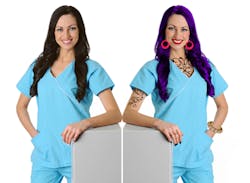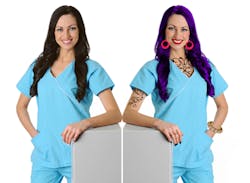Professionalism in dental hygiene: Keep your shine while shattering the cookie-cutter mold?
Can you keep your shine while shattering the cookie-cutter mold?
By Heidi Emmerling Muñoz, PhD
What does professional image mean in the dental community? Many would be puzzled that one would even have to define or describe professionalism, especially those who have been in the dental community for more than a few years. We just know it when we see it (or don't see it, whatever the case may be). But when challenged to articulate it, one quickly realizes that there are a number of explicit and implicit expectations that aren't necessarily shared by other professional communities. The word image usually implies the physical aspects-how dental hygienists dress, apply makeup, style their hair, groom their nails, and so forth. And in the relatively conservative dental community, this is usually fairly specific, prescriptive, and narrow, with little room for individual expression. However, professional image also embodies behavioral aspects-how one acts in and out of the office and how one behaves when nobody is looking. Individual practice expectations aside, many, if not all, licensing boards require behavior described as moral, ethical, and professional, which can be equally difficult to articulate, but board members know it when they see it. One's license can be jeopardized if the licensing board deems one's behavior immoral, unethical, or unprofessional.
Obviously it is important to define exactly what the expectations are before one goes about trying to improve one's self-image. And herein lies the point: the profession needs to have a discussion about professionalism and why the profession ascribes to those set ideals. The reason for this is there is a growing belief that professionalism is a social construct that is at best arbitrary and at worst oppressive, racist, sexist, classist, and more. For a well-written and -articulated piece on how dress codes and professionalism are oppressive in the business world, read what Carmen Rios presents in an article titled, "You Call It Professionalism; I Call It Oppression in a Three-Piece Suit."1
To apply Rios' concept to dental hygiene, picture the traditional expectations of what it means to look like/be a dental hygienist:
• Hair pulled back, off the shoulders
• Minimal, naturally applied makeup
• Jewelry limited to a wedding band and stud earrings (no more than one in each ear)
• No cologne
• Short fingernails, no polish or acrylic on nails
• Scrubs
• Plain black or white flat, closed-toe shoes that cover the heels
• No visible tattoos
• If male, facial hair, if present, should be closely trimmed
• Other (fill in other attributes you have observed as professional appearance)
Defining professional behavior too
Professional behavior is even more difficult to define-such as trying to define ethics, morality, or professionalism. However, because they have the force of law, it is important to know and abide by professional constructs. Sometimes it is easier to spot poor behavior than define good behavior. Bill Murphy, author of "10 Bad Habits That Make You Look Really Unprofessional,"2 outlines some of these items. The author states profanity, tardiness, leering, Pollyannaishness, disorganization, inarticulateness, secrecy, overpromising, cheating/lying as "credibility sucks." It's difficult to argue with this list. We're all human and slip up once in a while. If something slips, the best approach is to quickly apologize and continue with the opposite behavior. If you notice any of these habits regularly creeping in, it might be time to check them.
After writing what not to do, the same author wrote a sequel: "17 Habits That Make You Look More Professional."3 In this piece, he argues that confidence, self-awareness, strategic thinking, anticipation, caring, realism, follow-through, enthusiasm (as opposed to Pollyannaishness), diligence, performance, discretion, curiosity, risk taking, humor, fitness, and authenticity are attributes that demonstrate professionalism.
Related to confidence, I would add posture and eye contact. Most have learned that an open posture, which involves keeping the trunk of the body open and exposed-i.e., no arms crossed in front of the chest-can indicate friendliness, openness, and willingness; closed posture, which involves hunching forward and keeping the arms and legs crossed, can show hostility, unfriendliness, and anxiety. As a caveat, some cultures would attribute the latter behavior to modesty and view it in a more positive light than do consultants or the dominant culture. The same is true for eye contact. Our dominant culture sees this as positive but others view it as rude or hostile.
Related to all of the professional habits Murphy mentions is manners. Even when things do not go as planned, control how you handle the situation. Be especially careful with online personae. Avoid the impulse to "snap" back with quick responses.
Now go back and check which of these bullet points are for cleanliness and/or the safety of the patient or dental hygienist. Unstable stilettos, hair falling into the field of vision, and long, pointy fingernails could certainly physically impair one's ability to work as a dental hygienist.
However, some "rules" are more arbitrary: Why must shoes be black or white? Can't the shoes be neon pink leopard-patterned fuchsia as long as they are safe? Do false eyelashes, bright blush, facial hair, crooked teeth, and/or cherry-red lipstick put anyone at risk? How do tattoos hinder one's ability to scale? If wedding rings and stud earrings are acceptable, why is it that pinky rings, ear gauges, or nose rings are unacceptable? Do bacteria avoid wedding rings and stud earrings in favor of the more deviant nose ring or hoop earring?
Does professionalism counter diversity?
The cause for concern when narrowing the expectations of appropriate professional appearance of a dental hygienist is that doing so eliminates not only self-expression but diversity and entire populations. It was not long ago that the traditional dental hygienist was usually young, white, and female. And cute. Some of the more tacit rules are chilling. One would need to have the right appearance in the way of size, shape, gait, age, teeth alignment, gender expression, and so forth. Some of the expectations the dental community calls professional are indeed racist and sexist, such as prohibiting hijabs, dreadlocks, facial hair, and androgynous hairstyles. Women must be careful not to look too feminine (don't show too much cleavage, legs, or curves) or too frumpy or too masculine. Women of color are often discouraged from wearing their hair natural.
When I was a delegate to the ADHA in the mid-1990s, the house resolved to increase diversity within the profession. Sadly, this is happening at a snail's pace. Some would argue that the social construct of professional image that the dental profession has clung to is a major contributor to this problem of lack of diversity. Existing rules of professional appearance communicates to those who don't naturally fit into the narrow mold that they do not belong and are not good enough unless they change or pretend to be something they are not.
As the global community continues to shrink, as the profession aims to embrace diversity, then imposing arbitrary expectations is counterproductive, restrictive, and dangerous. Those who do not fit the cookie-cutter mold experience what is termed devaluation.
Who came up with these rules that have been in place for eons? Many years ago, those in power (heterosexual white cis-males) created the explicit and tacit expectations, and these expectations have been hard to shake. Granted, business owners have the right to require individual dress codes. But there is a consequence. And if the dental profession chooses to hold to the traditional physical expectations, then let's be honest, own it, and call it what it is: a social construct, not patient or operator safety. Nor should the profession equate adherence to the construct with one's professional skill and ability.
Crafting a professional image
In an ideal world, dental hygienists would have the freedom to craft their own professional image/ brand that is reflective of the values, beliefs, and ideals to which they ascribe while still adhering to the mandatory safety issues. Dental hygienists who want assistance fine-tuning their image can employ an image consultant through the Association of Image Consultants International. Consultants offer services such as wardrobe consultations, color consultations, personal shopping, clothing or uniform design, hair and makeup styling, etiquette consultations, executive presence coaching, fashion feng shui, and image branding.
Also, value your reputation. Make sure Facebook, LinkedIn, and Twitter accounts don't reveal information about personal lives that could tarnish professional lives. Warren Buffett is credited with saying, "It takes 20 years to build a reputation and five minutes to ruin it. If you think about that, you'll do things differently."
Another item I would add would be lifelong learning. A true professional keeps learning and also shares that knowledge. Sign up for CE, join study clubs, read journals, and attend conferences. Consider presenting a workshop or writing an article on something about which you have special knowledge or a skill set.
Mallory Stark, author of "Creating a Positive Professional Image" writes that people must create their own professional image or someone else will. The author suggests that in order to control one's professional image, one must assess the current image, culture, and audience by determining the expectations for professionalism and how others perceive them. In other words, know what the dental profession's expectations are. Next, conduct a cost-benefit analysis for image change. How much would it cost in terms of money, time, effort, individuality, and so forth to fit in? One must ask: Do I care about others' perceptions of me? Am I capable of changing my image? Are the benefits worth the costs (cognitive, psychological, emotional, physical effort)? Once one has conducted the cost-benefit analysis, one should use strategic self-presentation to manage impressions and change the image. For example:
• Employ appropriate traditional and social identity-based impression management strategies.
• Pay attention to the balancing act-build credibility while maintaining authenticity.
Finally, one must manage the effort one invests in the process by monitoring others' perceptions and monitoring one's behavior.
In applying the concept of cost-benefit analysis of professionalism to dentistry, one might ask how much it would cost to remove tattoos or if one is even interested in concealing them. What would one gain? Is it worth the financial, emotional, and physical cost? What about orthodontics? A wardrobe overhaul? A change in hairstyle or makeup application?
What about behavioral aspects? In the traditional gendered structure of dental hygiene, hygienists have been expected to behave in a relatively subordinate manner. One might be unable or unwilling to adopt that mannerism. Thus, regardless of the possible benefits, the cost would be too high. If the employer is willing and able to accept a more dominant behavior, then the cost-benefit is worth it. Similarly, one might not have a problem adopting a subordinate demeanor during work hours if the benefits one gains are worth it. Some of the habits listed above require significant cognitive, emotional and financial costs. In spite of this, true professionals see and reap the overwhelming positive rewards.
Finally, professionals are tolerant and culturally sensitive. Professionals are resilient. Professionals don't stay stuck in antiquated beliefs and behaviors. Let's not be afraid to examine and continue discussing both explicit and implicit physical, cognitive, and behavioral ideals we have constructed. RDH
Heidi Emmerling Muñoz, PhD, is a professor of English at Cosumnes River College where she has designed courses and teaches all levels of writing. Dr. Muñoz is also a delegate to the American Federation of Teachers (AFT) union. Prior to her current position, Dr. Muñoz was a CODA Site Consultant with the ADA, interim director, professor of dental hygiene at Sacramento City College, and private practice clinical dental hygienist for more than 20 years. She has written numerous articles and columns and is a frequent contributor to RDH. Dr. Muñoz can be reached at [email protected].
References
1. http://everydayfeminism.com/2015/02/professionalism-and-oppression/
2. http://www.inc.com/bill-murphy-jr/10-bad-habits-that-make-you-look-really-unprofessional.html
3. http://www.inc.com/bill-murphy-jr/17-simple-habits-that-make-you-look-more-professional.html
4. http://hbswk.hbs.edu/item/4860.html

